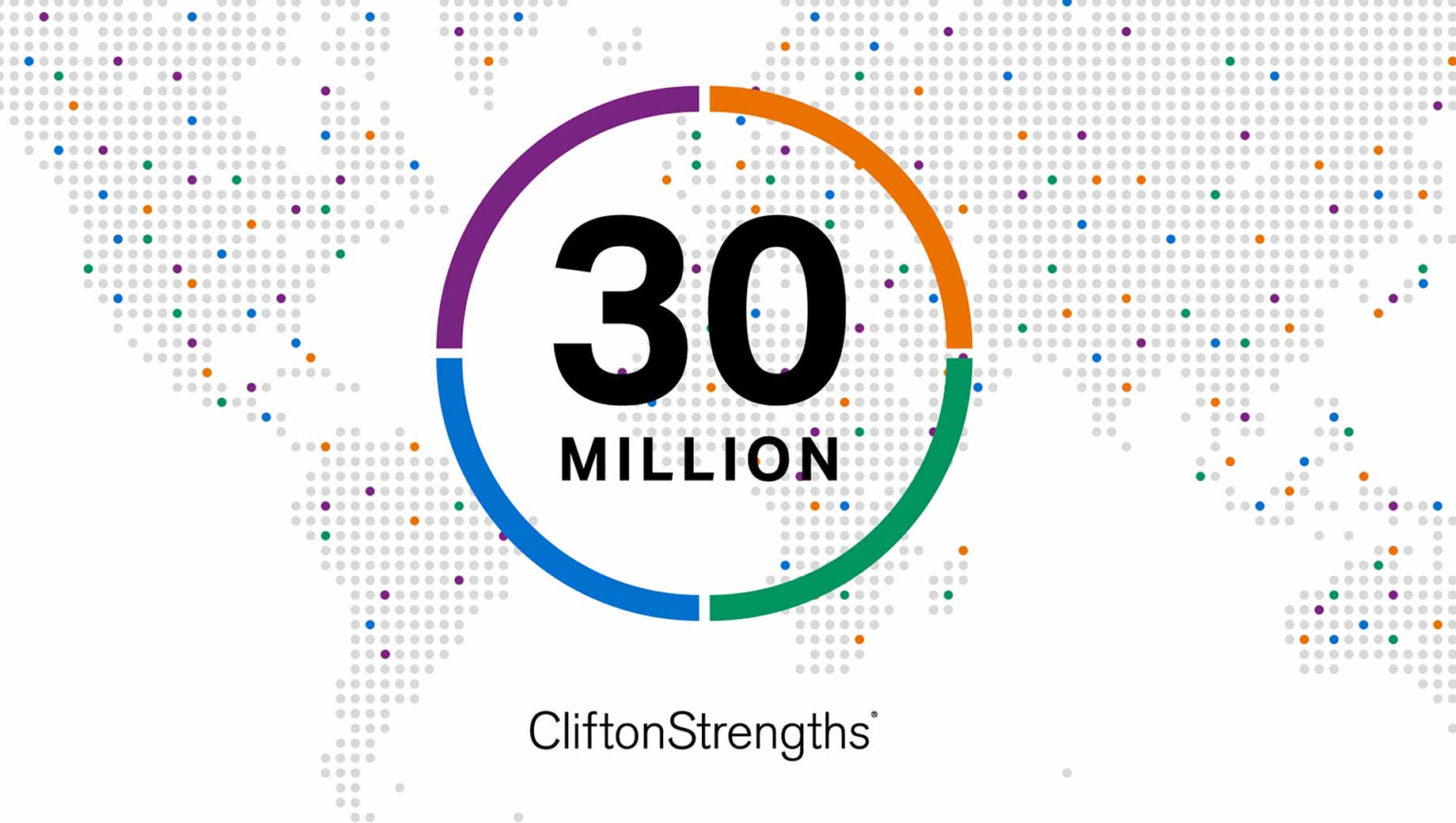Story Highlights
- In its first year, nearly 19,000 people took the CliftonStrengths assessment (StrengthsFinder®)
- Over time, role-based CliftonStrengths reports were developed
- CliftonStrengths has a role to play in stopping the global rise in unhappiness
Six decades ago, Don Clifton asked, “What would happen if we studied what was right with people versus what’s wrong with people?” This launched what would eventually become a global strengths movement.
As awareness and acceptance of this mindset continued to grow, so has the number of people completing the CliftonStrengths assessment. Today the assessment named in Clifton’s honor was completed for the 30 millionth time.
In celebration of this milestone, we wanted to revisit Clifton’s original mission, how it’s being applied today and share some of the most important questions our experts plan to explore next.
The Origin of CliftonStrengths
The CliftonStrengths assessment (called the Clifton StrengthsFinder at the time) was launched in 1999 as an objective measure of personal talent that could be administered online. Just under 19,000 people completed the assessment that first year, truly a feat considering everything about this assessment was novel: from the survey methods (in the era of dial-up internet, online assessments were less common) to the concepts proven (most leaders at the time believed they could find more success in fixing weaknesses rather than working around them).
During these early years, much of the work of CliftonStrengths was to spread awareness of the efficacy and potential outcomes if one did “focus on strengths and manage weaknesses,” as Clifton challenged. A lot of resources and time were invested in education to help people understand the value of strengths and the potential they can unlock.
That investment paid off. Over time, people saw the validity and inherent helpfulness of discovering their strengths. The concept of investing in what one is naturally good at to further develop that talent as opposed to one’s weaknesses took root and began to grow. Gallup’s CliftonStrengths offerings evolved to match that growth, providing more customized and targeted developmental tools.
Where We Find Ourselves Today
As of today, 30 million people have discovered what is uniquely right about them, but, as any strengths enthusiast will tell you, identifying one’s strengths is just the first step. It’s the development and application of one’s strengths that allows each of us to truly reach our potential.
That’s why Gallup is committed to making strengths more practical and easier to apply in everyday life. As part of that commitment, we’ve observed how people have learned to use the CliftonStrengths science over the past 20-plus years and paid specific attention to how they use it for development. Over time, we’ve figured out how to provide better, more individualized feedback in accessible pieces.
As of today, 30 million people have discovered what is uniquely right about them, but, as any strengths enthusiast will tell you, identifying one’s strengths is just the first step.
The first major report customization came in 2007 when StrengthsFinder 2.0 was published. The book included a new version of the assessment that generated a Strengths Insights Guide -- a personalized set of insights specific to each individual’s unique top five. Observing just how deeply these custom insights resonated with individuals encouraged us to continue exploring ways to support strengths development by making it more personal and more directly applicable to a range of specific roles and environments.
As the strengths community grew, so did the number of Gallup-Certified Strengths Coaches. We launched the Gallup Called to Coach webcast series in 2013 as a resource for those who want to help others discover their strengths. The webcast is now a podcast in the middle of season 11. It is part of a robust offering of resources available for the coaching community, including the newer CliftonStrengths podcast, an annual learning series and bimonthly community calls to ensure coaches have access to the latest strengths tools and resources.
Coaches, for example, were among the first to learn about our redesigned CliftonStrengths 34 report. Launched in 2018, this report shares the individual’s rank order of all 34 themes and includes action items, tips for navigating blind spots and calls attention to areas of excellence.
Sharing these types of highly individualized, actionable insights is how we can deliver on our commitment to make strengths more practical and applicable in daily life. That’s why, more recently, in addition to the existing Top 5 and CliftonStrengths 34 reports, we developed a suite of role-based reports for:
- Leaders
- Managers
- Salespeople
- Students
These reports provide specific, action-oriented advice and insights to help individuals in these roles better use their strengths in their daily life. The advice and insights in these reports were only made possible by the growing strengths community, which helps our experts analyze even more findings.
Beyond helping people develop their strengths, we’re motivated to help individuals learn how to apply them to have better days. On a macro-level, this looks like advocating for and spreading awareness of the benefits for employees and leaders alike in strengths-based organizations -- increased engagement, profit, and sales and lower attrition.
But on a micro-level, it can mean taking pressing issues and asking if strengths can help. Most recently, the prevalence of burnout in the global workforce prompted Gallup to see if people with different strengths chose different ways of coping with burnout. The result? An article sharing our findings and a downloadable guide to help individuals prevent and overcome burnout.
In addition to trying to help today’s adults experience better days more often, Gallup is passionate about partnering with educational institutions to help inspire the next generation to achieve even more. Researchers at several universities have found that investing in their students’ strengths increases the likelihood of student success in school.
In addition to trying to help today’s adults experience better days more often, Gallup is passionate about partnering with educational institutions to help inspire the next generation to achieve even more.
Different schools have defined success in various ways, including student retention, life satisfaction, academic engagement and hope. Gallup researchers are currently reviewing the academic literature and will share our findings once published so that other schools can benefit from what these pioneering universities have learned.
So What’s Next?
Shifting our focus to the future and the next 30 million people to discover their strengths, we wanted to share some of the important questions and topics our experts hope to explore next:
- How can we best use strengths to improve wellbeing? Our initial work on answering this question was published in Wellbeing at Work, but we want to delve more into the connection between strengths and wellbeing in the hope of combating the global rise in unhappiness.
- How can artificial intelligence reliably enhance CliftonStrengths content? For example, we are exploring using AI translation tools to help expand access to CliftonStrengths to more people worldwide.
- Can we help people more easily integrate strengths into employee engagement and performance conversations? Integrating strengths into employee feedback improves their performance, so we’re exploring ways to make it easier for managers and leaders to do this.
- Whom can we partner with to further advance this movement? Developing reciprocal partnerships will help us continue to expand strengths. This includes licensed partners teaching courses on behalf of Gallup and opportunities like Catalyst, a program where strengths advocates can submit their technologies or ideas for enhancing the science or practice of strengths.
As with all our strengths research and findings, we don’t yet know where the above questions and our subsequent research will lead. That is a vital part of this work we’re called to do and a point of pride: We ask the questions but let the science and data lead us.
We may not know what our next questions will uncover just yet, but rest assured we’ll continue to share our findings as soon as possible. It’s our mission, after all, to help the world discover and use their strengths every day.
Use CliftonStrengths to promote development and increase performance in your organization:
- Discover how to create a strengths-based culture that attracts top talent and encourages organic growth.
- Learn how the CliftonStrengths for Leaders report can help your leaders make the most of their natural talents.
- Subscribe to the CliftonStrengths newsletter for more CliftonStrengths content and insights.
CliftonStrengths® and each of the 34 CliftonStrengths theme names are trademarks of Gallup. Copyright © 2000 Gallup, Inc. All rights reserved.





